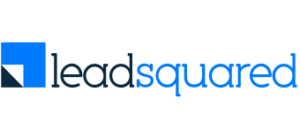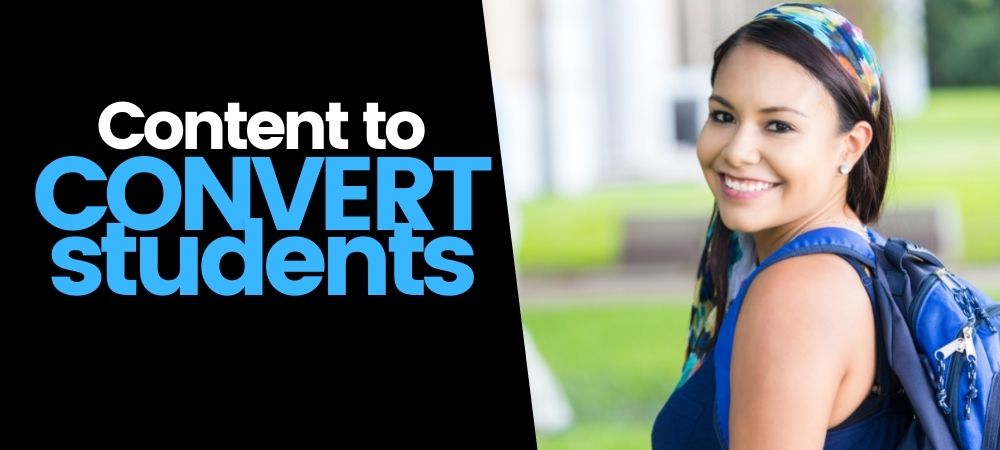- 1. Understanding the Importance of Content Marketing for Higher Education
- 2. How to Develop a Content Marketing Strategy that Works
- 3. Key Content Marketing Strategies for Higher Education
- 4. Measuring Content Marketing Success in Higher Education
- 5. Future Trends in Higher Education Content Marketing
- 6. In Conclusion
- 7. Frequently Asked Questions (FAQs)
You’ve probably been asked to refresh your education institution’s content marketing strategy in the light of changing student demographics, enrollment declines, and – more than anything else – the ongoing federal policy changes. Or, maybe marketing has taken a complete backseat, and your institution is completely preoccupied with the changes as they unfold.
It’s valid to be concerned. But it’s important to ensure that your communication and enrollment plans don’t waver.
A plan to run your higher education institution’s marketing with clarity, consistency and authenticity….a plan that reaffirms your values loud and clear….would not only help your institution get through these uncertainties, but also give your prospective students confidence that your institution will always prioritize their well-being and success, no matter what happens.
“When you come to the end of your rope, tie a knot and hang on.” – Franklin D. Roosevelt.
To get more stats about the state of higher education right now, you can go to this article by InsideHigherEd. As for us, let’s dive right into higher education content marketing strategies.
Understanding the Importance of Content Marketing for Higher Education
Content marketing helps institutions differentiate themselves, establish trust, and provide valuable insights that guide students through their decision-making journey. Below are some numbers to put this into perspective!
(Source: SearchInfluence)
To summarize the research, most of the surveyed education marketers (84%) understand the value of SEO — but only 27% invest in it. Meanwhile, 91% lean heavily on paid channels, driving up the average cost per inquiry to $157 for graduate programs. A stronger focus on organic visibility could bring that number down significantly.
SEO is just one small piece of the content marketing puzzle, yet this data highlights how underutilized organic strategies are in higher education. A well-planned content marketing approach – focused on valuable, search-optimized content – can increase reach, enhance student engagement, and reduce reliance on expensive paid ads by driving organic (free) traffic.
That’s the power of a well-planned higher education content marketing strategy. You can reduce the cost of acquiring students, and you know how important that is right now when budgets are uncertain.
Now that we have had a glimpse of how underutilized content is in higher education marketing, let’s discuss building a content marketing strategy that actually works:
How to Develop a Content Marketing Strategy that Works
1. Know your audience
Identify your prospective students to create messaging that truly resonates:
- Who are they? (Demographics, backgrounds).
- What stage of life are they in? Are they traditional learners, or are they adult learners who focus on continued education?
- What do they care about? (Campus life, extracurriculars, career prospects, networking opportunities, and research programs).
- What challenges do they encounter? Financial concerns, or something else?
- What motivates them to seek higher education? Are they aiming for career growth, personal development, or acquiring a specific skill set?
It’s essential to understand their values, the issues they wish to address, and their long-term aspirations. Additionally, consider the importance they place on aspects such as flexibility, affordability, location, and networking opportunities.
- How do they consume content?
Equally crucial is understanding how these potential students engage with content. Are they mainly active on social media platforms like Instagram or TikTok, or are they professionals active on LinkedIn? Do they lean towards reading in-depth articles or prefer watching short-form videos and reels? Some students may respond more positively to visual content, while others might be more interested in comprehensive articles or interactive experiences.
In Practice:
Let’s take a search term a student might use and dig into the demographics and interests. (Tool Used: SparkToro)
We chose the keyword: “top performing arts colleges” to do the analysis.
a) Here are the top websites being visited by these students:


b) Here are the social networks used by them:

c) The social accounts followed by them:

d) The content they consume:

This exercise would give you a clear 1st step to creating your higher education content marketing strategy. You’d know the right platforms, content, and channels to use.
2. Set clear goals
Define what success looks like for your content marketing strategy – boosting website traffic, generating leads, or improving enrollment rates – so that every piece of content has a purpose and contributes to your broader marketing efforts.
Once you define your goals, break them down into actionable steps that can be tracked and measured. For instance, if your goal is to increase applications for a new Data Science program, here’s how you can break it down.

Consider using tools like Google Analytics to monitor visitor behavior and pinpoint which content and channel is generating the most engagement for the said course. Establish clear conversion paths and make sure your calls-to-action (CTAs) are optimized to encourage prospective students to take the next step.
Having this solid understanding also enables you to assess the performance of your content over time. Whether it’s through the number of student inquiries, the quality of the audience engaging with your content, or an increase in applications, measurable goals provide the insights necessary to continuously refine and enhance your strategy.
3. Choose the right channels
Choosing the right channels for your higher education content marketing efforts is essential for effectively reaching and engaging your target audience. Not every social media platform, site, or communication method will resonate with every prospective student. By understanding your audience’s preferences, you can select the channels that will have the greatest impact and help you meet your objectives. Start by examining where your prospective students are most active.
For instance:
- Younger audiences may lean towards platforms like Instagram, TikTok, and Snapchat, where visually appealing and short-form content (such as stories, reels, and videos) thrives.
- Conversely, older or more professional audiences might favor LinkedIn for career-related information, including program offerings and alum success stories.
- Your website also plays a vital role in the content strategy. (According to Searchinfluence, more than 90% of prospective students visit an institution’s website in their search for higher education programs).
- Prospective students frequently use search engines to research programs, scholarships, and university rankings. A well-optimized blog filled with informative content can attract organic traffic and build trust over time.
- Education influencers – identify the influencers that your audience follows. (Again, audience research tools like SparkToro can help you identify this.)
- Long-form articles, student testimonials, program guides, and career outcome data are all valuable content pieces that can address the questions and concerns of prospective students.
- Additionally, don’t overlook the importance of higher education email marketing.
4. Create a content calendar
Creating a content calendar allows institutions to effectively plan, organize, and align their marketing strategies with important academic events, deadlines, and promotional periods. A well-organized content calendar helps colleges and universities maintain a consistent and relevant online presence across various platforms, such as social media, blogs, email newsletters, and websites. By planning content in advance, marketing teams can ensure they address prospective students’ questions and concerns at the right times, whether during the application process, enrollment period, or orientation. Additionally, it streamlines the content creation process, minimizing missed opportunities for timely engagement.
In the realm of higher education marketing, a content calendar also fosters better collaboration among departments, ensuring that marketing efforts align with admissions, faculty, alum relations, and student services. Institutions can plan content around significant events like open houses, campus tours, scholarship deadlines, and graduation ceremonies, ensuring that each piece of content supports the broader goals of recruitment, retention, and community building.
5. Ensure the messaging fits
Aligning the tone, language, and main themes of the content messaging with the right target audience is important. This will help them find resonance, preserving authenticity and consistency throughout all communication platforms. Higher education prospects can roughly be broken down into:
1. Intended students — prospects who’ve expressed a legitimate interest in applying to your institution.
Content messaging for this group should be centered on differentiating your school from its competitors and highlighting your unique selling points. For intended students, you’ll want to create:
- Case studies in the form of student/graduate success stories
For example, here’s how the Clemson University does it.
- Personalized outreach emails
- Open houses/simulated classes designed specifically for recruits
2. Applicants — students who’ve filled out the requisite forms and hit “send” on their applications.
This group has decided to invest time and money into landing a spot at your institution. Of course, this doesn’t mean they haven’t applied elsewhere.
Students at this stage need to be kept “warm” with increased person-to-person contact from your team, such as:
- Financial aid counseling
- Relationship-building events such as campus tours, webinars, or informal video meetings
- Social media outreach initiated by existing students, professors, or staff
3. Accepted applicants — students who’ve been accepted to your institution and/or begun the enrollment process in some capacity.
Of course, accepted applicants are still prospects, so your admissions team must nurture them and hold their attention until they sign on the dotted line. Content for accepted applicants should be even more granular in its approach, ramping up interpersonal outreach efforts and providing detailed, informative answers to their questions through projects such as:
- Digital course catalogs (complete with images, video clips, and registration forms)
- Social media meetups that allow accepted applicants to chat with one another or introduce themselves to existing students
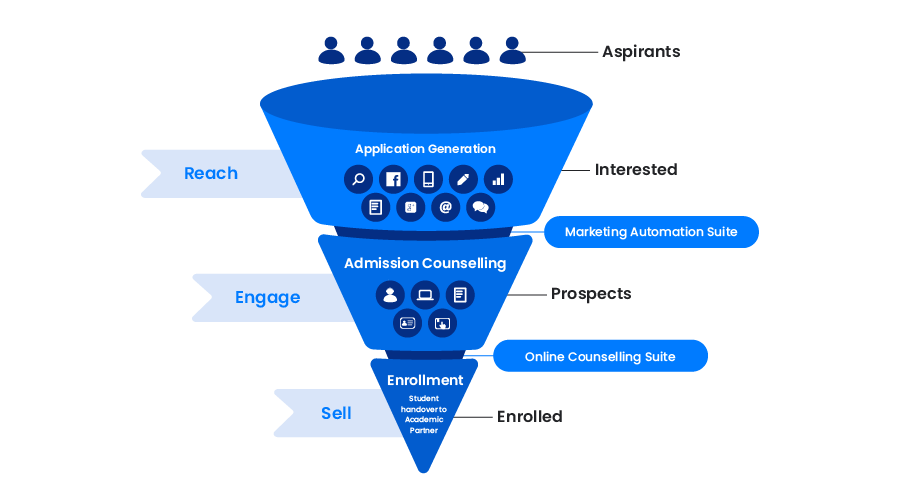
Note that failing to cultivate genuine connections with accepted applicants can result in lower yield percentages and higher melt rates. Content for these audiences should be expertly curated, personalized, and distributed with care.
6. Personalize content
Personalization has become essential in higher education marketing, rather than just a nice-to-have. It has a proven track record and can remove the “feeling like a number” syndrome that tends to alienate prospects across nearly every industry. Prospective students seek content that resonates with their needs, interests, and aspirations. This approach helps connect a university’s programs with a student’s personal goals.
Here are some effective ways to implement personalization in content marketing for higher education:
a. Dynamic Website Content: Over 90% of potential students look for higher education programs on an institution’s website. Students who visit an educational institute’s website often seek specific information about programs, campus life, admissions, and financial aid. By utilizing dynamic content — such as personalized landing pages or program-specific content — colleges can speak directly to the individual visitor’s interests.

As you can see in the above example, Drexel University has placed call-to-action (CTA) buttons thoughtfully. Effectively directing user behavior, the CTAs are made to be visually appealing without being intrusive, whether they are urging potential students to apply, welcoming guests to an open house, or asking alumni to make a donation. Also, whether you are a student, a family member of the student, an alum, or a faculty member – you have separate pages and sections on the website to access the information you need.
Tools like LeadSquared can help track which pages a student views, and help trigger personalized follow-up content or offers based on their interests.
b. Personalized Email Campaigns: Higher education institutions can enhance email engagement by tailoring messages based on student profiles. These could include personalized subject lines, content related to their academic interests, or invitations to events that match their timeline or location. Personalized email campaigns keep prospective students engaged and help foster a stronger connection with the institution.
Even after the student is enrolled, sending personalized messages (via email and social media) that celebrate their commitment, share important next steps, and remind them about registration, housing, and orientation deadlines can help maintain their excitement and engagement. Additionally, sending “getting ready for college” tips, introducing them to professors, or connecting them with other incoming students via social media groups fosters a sense of community before the student even arrives on campus.
LeadSquared’s CRM and automation features allow universities to manage and personalize these communications efficiently, by making it easier to segment student lists and deliver highly personalized, timely messages.
c. Targeted Social Media Content: Social media platforms like Instagram, Facebook, and LinkedIn provide opportunities for universities to create targeted content based on student demographics and interests. By using analytics to understand a student’s behavior, institutions can serve tailored content that addresses specific concerns, such as campus culture, internships, or career outcomes.
Key Content Marketing Strategies for Higher Education
By creating relevant, compelling, and informative content, institutions can nurture prospective students and guide them through each stage of the enrollment journey. Here are some key tactics for higher education content marketing:
1. Educational blogs and articles
Blog posts and articles serve as an effective means to address the questions and concerns of potential students. Whether it’s about understanding financial aid or choosing a major, students frequently seek answers online.
By crafting blog posts that deliver useful insights, such as “What to Expect During Freshman Year” or “How to Choose the Right College Program”, universities can establish themselves as knowledgeable resources and foster trust with prospective students. A well-maintained blog allows institutions to directly address the challenges faced by their audience, encouraging them to revisit the website for more valuable information.

Tip: Using tools like Semrush, higher education institutions can take advantage of topic clusters, as you can see above. Topic clusters are a technique that improves SEO and facilitates user navigation by organizing similar material around a single, pillar topic. Higher education marketers can begin by choosing a broad, central topic (such as “best acting programs”) and then using Semrush’s keyword research tool to find long-tail keywords or related subtopics that fit students’ search intent.
For instance, a search for “What can expect during freshman year” may turn up certain subtopics like “Tips for adjusting to college life” or “Freshman year schedule examples.” Institutions can develop a robust content ecosystem that raises search engine rankings and maintains reader engagement by writing blog entries clustered around these subtopics:
- 10 Things Every Freshman Should Know Before Day One
- Virtual Campus Tours: What to Look For and How to Prepare
- Navigating Your First Year: A Month-by-Month Survival Guide
- Behind the Scenes: A Day in the Life of a Freshman at [Your College]
- Freshman FAQs Answered by Our Admissions Team
2. Video content and virtual tours
Video content and virtual tours have become vital tools for attracting prospective students today. Well-produced videos enable institutions to highlight their campus, facilities, and student life in ways that text and images simply can’t. Virtual tours give students the chance to explore the environment from the comfort of their homes, offering a genuine sense of the campus experience.
By showcasing important areas like lecture halls, dormitories, libraries, and recreational spaces, prospective students can better imagine themselves at the institution. These engaging experiences not only generate excitement but also create a stronger connection with the campus, which can significantly influence their decision to apply or enroll.
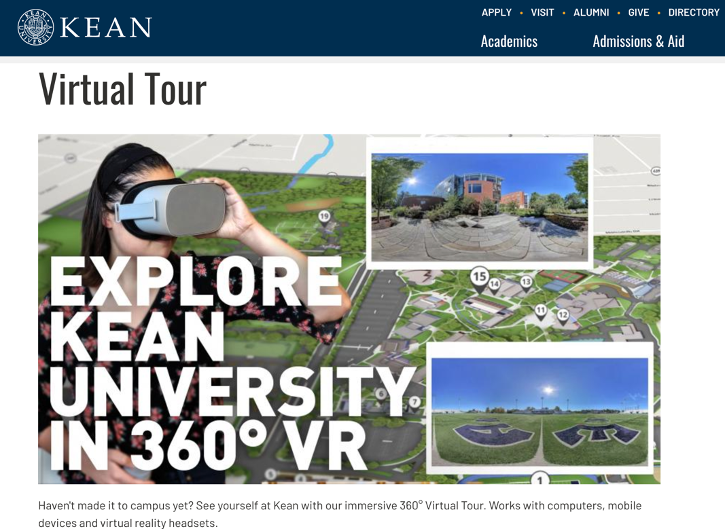
Quick Tip: Flostack can help you create a virtual tour microsite based on students’ interests.
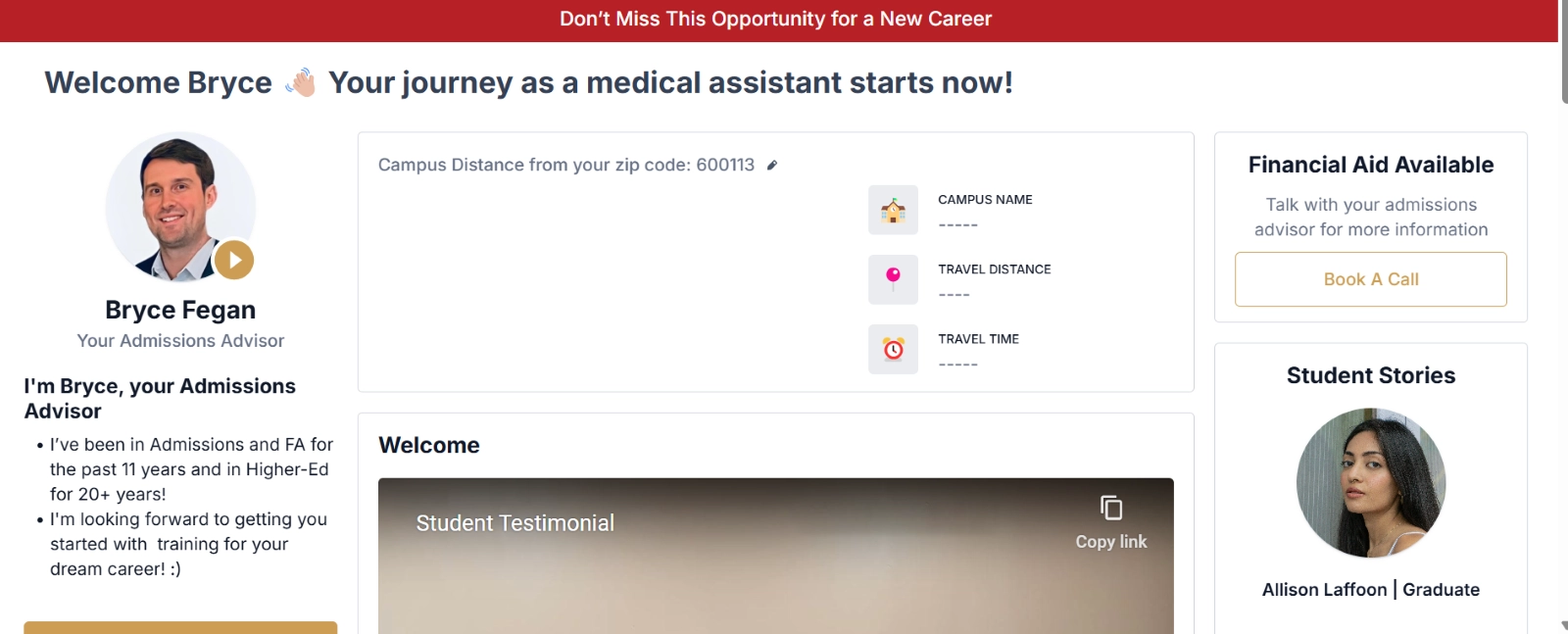
3. Social media marketing
Social media platforms are a powerful tool for higher education institutions to reach prospective students and promote their academic programs. By leveraging relevant social messaging, institutions can create a strong online presence, engage with their target audience, and drive enrollment. Here are some tips for leveraging social media to reach prospective students:
- Use relevant hashtags: Research and use relevant hashtags to increase the visibility of social media posts and attract prospective students.
- Create engaging content: Develop content that is informative, entertaining, and visually appealing to capture the attention of prospective students.
- Utilize Instagram and TikTok: These platforms are popular among prospective students, and institutions can use them to showcase their campus life, academic programs, and student success stories.
- Share user-generated content: Encourage current students and alums to share their experiences and stories on social media to create a sense of community and authenticity.
- Run social media ads: Use targeted social media ads to reach prospective students interested in specific academic programs or who have shown interest in the institution.
A good example of leveraging social media is how the University of Michigan creates student-focused content that resonates with popular Instagram and TikTok challenges. This tactic increases their enrollment rate by reaching a larger audience, especially high school students.

4. Email Marketing
Email marketing is a crucial distribution channel for higher education content marketing, as it facilitates direct communication with prospective students, current students, alums, and faculty. By leveraging a broad network of contacts, universities can customize email campaigns to provide personalized and relevant content tailored to the audience’s interests, enrollment stage, or academic aspirations.
Tools like LeadSquared enable institutions to efficiently manage and segment their email lists, ensuring that each message is targeted and pertinent. For prospective students, emails might feature details about program offerings, application deadlines, scholarships, and campus life, while current students may receive information on academic resources, events, and important announcements. Using LeadSquared’s automation features, universities can cultivate relationships and keep their audience engaged throughout their journey.
Moreover, using such platforms for effective email marketing in higher education allows institutions to monitor and evaluate the success of their campaigns. By analyzing metrics such as open rates, click-through rates, and conversion rates, universities can determine which content resonates best with their audience and adjust their strategies accordingly.
5. SEO for higher education websites
SEO (Search Engine Optimization) plays a vital role in content marketing for higher education websites, helping institutions boost their online presence and connect with prospective students. By incorporating relevant keywords, creating high-quality content, and designing an intuitive website structure, universities can ensure they show up in search results when students search for specific academic programs, campus details, or financial aid options.
Well-crafted, SEO-friendly content like blog posts, program descriptions, and landing pages not only enhances search rankings but also delivers valuable information to users, making it easier for them to find what they are looking for. It’s also crucial for the website to be mobile-friendly, load quickly, and provide a user-friendly experience to improve SEO performance and attract a wider audience. In the realm of higher education, SEO is more than just technical tweaks; it’s about crafting content that speaks to prospective students.
Universities can leverage local SEO to attract students from specific areas, helping them rank better for location-based searches such as “top universities in [city/state].”

Furthermore, establishing backlinks through guest blogging, partnerships, or features in educational publications can enhance credibility and improve search engine rankings. As students increasingly turn to search engines to explore their educational choices, effective SEO strategies allow institutions to remain competitive and ensure their content is easily found.
6. Webinars and virtual events
These platforms enable universities and colleges to connect with prospective students, alums, and educators in a lively and interactive manner. By hosting webinars on various subjects, such as program offerings, admissions processes, career opportunities, and campus life, institutions can share valuable information that aids in decision-making.
Furthermore, virtual events can feature live Q&A sessions, panel discussions, and interactive workshops, offering a more personalized and engaging experience compared to traditional content like brochures or static websites. This format encourages real-time communication, builds trust, and humanizes the institution, making it more approachable and attractive.
From a marketing standpoint, webinars and virtual events present a fantastic opportunity for higher education institutions to generate leads and enhance brand visibility. These events can be promoted through email campaigns, social media channels, and targeted advertisements, driving traffic to the event and reaching a broader audience. Additionally, they produce valuable content that can be transformed into blog posts, recorded sessions, or social media snippets, prolonging the content’s relevance!
7. Testimonials and other student-generated content
One of the most effective ways to influence prospective students is by showcasing the experiences of current students and alums. Authentic stories of student achievements, whether it’s overcoming obstacles or landing internships, have a greater impact than standard marketing messages.
These testimonials can be shared through written narratives, social media updates, or video interviews. When students can relate to these stories, they are more inclined to envision their own success at your institution, increasing the chances of their enrollment.
For instance, the University of Houston has a dedicated section on their website like this –

Also read: The Ultimate Guide to Higher Education Marketing: Strategies, Trends, and Tools for Success in 2025
Measuring Content Marketing Success in Higher Education
Measuring and optimizing content marketing success is crucial for higher education institutions to ensure that their content marketing strategy is effective and achieves its goals.
Key performance indicators (KPIs)
Here are some key metrics to measure and optimize content marketing success, while also giving you an idea of the Return on Investment (ROI) of your efforts:
- Student Acquisition Cost (CAC): The cost of acquiring a new student, calculated as Total Marketing Spend ÷ New Students.
- Average Cost Per Inquiry (CPI): The average cost incurred for each student inquiry, calculated as Total Marketing Spend ÷ Total Inquiries.
- Average Cost Per Enrolled Student: The average cost of acquiring each enrolled student, calculated as Total Marketing Spend ÷ Total Enrolled Students.
- Organic Search Traffic: Website visitors who arrive through unpaid search engine results, often tracked to gauge SEO performance.
- Lead generation or application ratios: Track the number of leads or applications generated from content marketing efforts
- SEO Conversions: The number of desired actions (e.g., applications, sign-ups) generated from organic search traffic, reflecting the effectiveness of SEO efforts.
Tools
Various tools can be useful for engaging prospective students, faculty, and alums while strengthening the institution’s brand.
- Content management systems (CMS) such as WordPress or Drupal are vital for creating and managing dynamic websites that contain important information, blog posts, and event updates.
- Design Tools like Canva and Adobe Spark enable institutions to design visually appealing graphics and videos that can be shared on social media platforms. These resources help colleges and universities maintain a consistent and professional online presence that resonates with their target audience.
- Marketing Automation Platforms like LeadSquared, HubSpot, and Mailchimp offer advanced email marketing solutions to nurture prospective students through personalized email campaigns, automated workflows, and lead tracking.
- Analytics tools like Google Analytics and SEMrush are useful for tracking the effectiveness of content marketing campaigns, providing insights into which content resonates best with the audience.
- Social media management tools such as Hootsuite or Buffer allow higher education institutions to schedule and analyze posts across various platforms, ensuring that the content reaches the right audience at the right time.
- SEO tools like SEMRush, Moz and Ahrefs assist in optimizing website content to ensure that the institution’s pages rank high on search engines, making it easier for prospective students to find relevant information.
By combining these tools, including LeadSquared’s lead management and nurturing features, and Flostack’s Student Engagement Solutions, institutions can effectively strategize, execute, and measure their content marketing efforts to enhance engagement and boost admissions.
Test, measure, repeat
The process of testing, measuring, and refining strategies is crucial for achieving optimal results. By experimenting with various types of content—such as blog posts, videos, or social media updates—institutions can determine what resonates best with their audience.
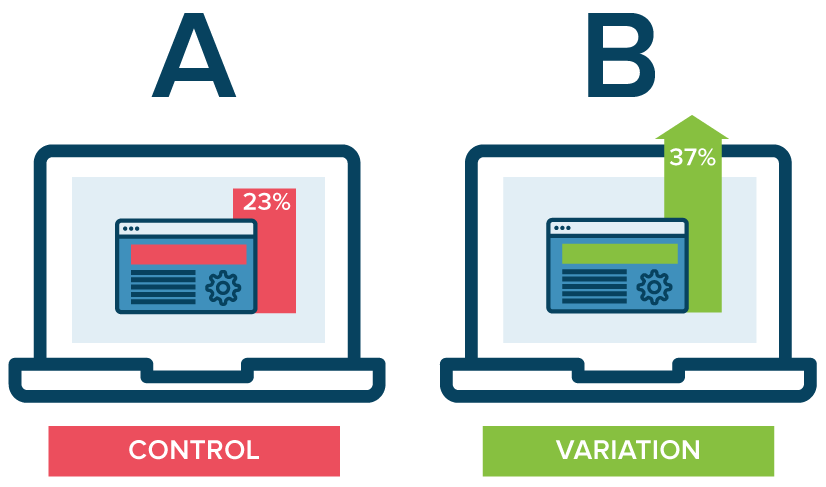
For instance, A/B testing (or split testing) can be employed to compare two versions of a landing page or email campaign to see which one generates more conversions or engagement. This enables colleges and universities to continuously adapt their content and messaging to better meet the needs and preferences of prospective students. Exploring new ideas, formats, and channels ensures that marketing efforts remain fresh and relevant, keeping the audience engaged.
Measuring the outcomes of content marketing initiatives is equally important, as it offers valuable insights into what is effective and what isn’t. Tools like Google Analytics, and CRM platforms such as LeadSquared assist in tracking key metrics, including website traffic, conversion rates, and engagement levels. By consistently analyzing these data points, higher education marketers can spot trends and identify areas for improvement.
The key is to repeat the cycle—adjusting strategies based on insights and re-testing to ensure ongoing growth. With each iteration, institutions can refine their approach, boosting their overall content marketing effectiveness and ultimately increasing engagement, applications, and enrollment rates.
Future Trends in Higher Education Content Marketing
As prospective students become more selective and research-driven, colleges and universities will need to leverage advanced tools, such as AI and machine learning, to create personalized content that speaks directly to individual interests and needs. This could include tailored email campaigns, personalized website experiences, and content that speaks to specific student demographics or academic goals.
The rise of AI-driven content creation and personalization
The emergence of AI-driven content creation and personalization is a double-edged sword and should be treated as such. Artificial intelligence can sift through extensive data to identify patterns and preferences, allowing institutions to craft highly targeted content that resonates with specific audience segments.
For example, AI can assist in generating personalized emails, suggesting courses aligned with a student’s interests, or customizing website content based on a user’s browsing habits and behaviors. By automating these tasks, colleges and universities can offer timely, relevant content that caters to the unique needs of each individual, ultimately boosting engagement and conversions. AI-driven content creation tools can also enhance SEO efforts by analyzing search trends and recommending keywords, thereby improving organic reach. As AI technology continues to advance, so does its capacity to create more dynamic and engaging experiences.
However, it’s crucial to remember that even though AI can expedite processes, proper supervision is still necessary. Finding the ideal balance between human experience and AI-generated content is essential. Although AI can help with content marketing, human interaction is what keeps the content interesting, genuine, and consistent with the institution’s ideals.
Interactive content
Interactive content, including quizzes, chatbots, and gamified experiences, is becoming a vital part of content marketing in education, providing innovative ways to engage potential students.
For instance:
- Quizzes can direct students to suitable programs or offer personalized career advice based on their answers, resulting in a more engaging and informative experience.
- AI-powered chatbots are also crucial, delivering instant responses to questions, offering tailored guidance, and improving user experience on websites and social media.
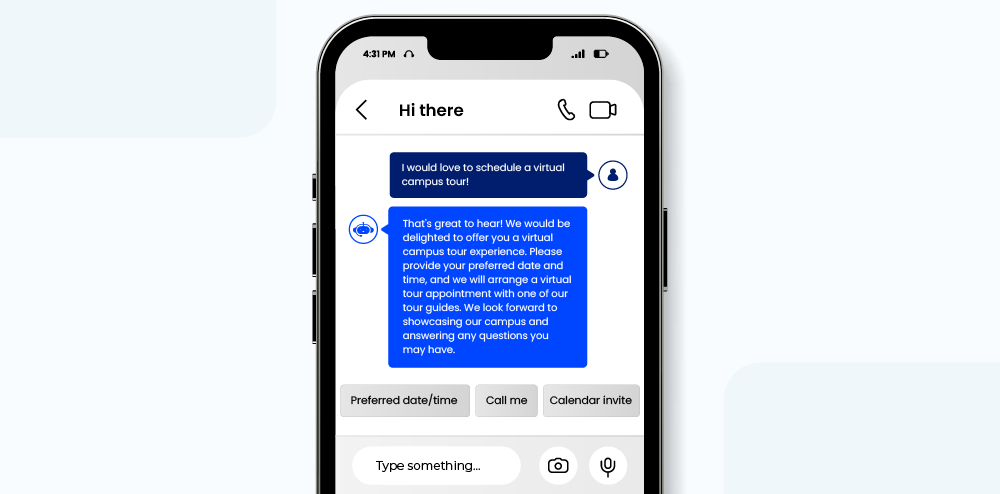
- Gamified experiences represent another exciting trend that can enhance engagement by introducing elements of fun and competition. By integrating game-like features—such as challenges, rewards, and progress tracking—educational institutions can create more dynamic and memorable experiences that resonate with prospective students, particularly younger generations who are used to digital interactivity.

A good example is University of Arizona’s “UAccess” portal. The institution incorporates gamified aspects in its portal to engage students. Students can accrue points through UAccess by doing things like signing up for classes, going to events, and taking part in different campus activities. These points can be kept track of, exchanged for incentives, or applied to improve the overall experience of the students.
These interactive features not only grab attention but also motivate prospective students to engage actively with the content, making their research and decision-making process more enjoyable and customized to their preferences. Ultimately, interactive content provides a more personalized, immersive experience, helping to boost engagement and strengthen the bond between students and educational institutions.
Voice search and mobile-first content strategies
As voice search continues to rise in popularity, particularly with the widespread use of voice-activated devices like smartphones and smart speakers, educational institutions are adapting their content marketing strategies to optimize for voice search. Unlike traditional search queries, voice searches tend to be more conversational and question-based, which means content needs to be tailored to answer specific questions that prospective students might ask.
For example, institutions can optimize their FAQs, blog posts, and landing pages to align with natural language patterns, focusing on long-tail keywords and phrases that are commonly spoken rather than typed. By doing so, colleges and universities can improve their chances of appearing in voice search results and make it easier for potential students to find answers quickly, enhancing the user experience.
Simultaneously, mobile-first strategies are becoming increasingly crucial. Nearly 45% of students say they are constantly online, even when they are in class. Nowadays, a sizable portion of educational searches are conducted on tablets and smartphones. As a large portion of prospective students browse websites, apply, and engage with content via smartphones, institutions must ensure that their websites and content are mobile-friendly. This includes responsive design, fast loading speeds, and easy navigation for mobile users. Mobile optimization also extends to social media platforms, email marketing, and online advertisements, all of which must be designed with mobile engagement in mind.
By focusing on voice search and mobile-first strategies, educational institutions can reach a broader audience, increase accessibility, and provide a more seamless and user-friendly experience that aligns with how students are searching for and consuming information today.
In Conclusion
The education space is highly competitive. By adopting personalized, relevant, and engaging content approaches, universities can effectively reach out to prospective students, assist them in their decision-making process, and ensure they remain committed after enrollment. By leveraging tools, dynamic content, and targeted communication, universities can build trust, generate excitement, and establish a stronger connection with students.
Content marketing can significantly improve enrollment results, increase yield rates, and decrease melt when implemented effectively. It ultimately contributes to the long-term success of higher education institutions.
With tools like LeadSquared, educational institutions can enhance their marketing strategies, monitor student engagement more efficiently, and improve retention rates.
See how LeadSquared can help you refine your approach and achieve better outcomes for your educational institution.
Frequently Asked Questions (FAQs)
1. How can higher education marketers measure the ROI of their content marketing campaigns?
Use data-driven solutions like LeadSquared to monitor key performance indicators (KPIs), including engagement rates, conversion metrics, and enrollment growth.
2. Why should higher education institutions use automation to improve their content marketing?
Higher education institutions can save a lot of time and increase efficacy by using marketing automation solutions like LeadSquared to offer personalized content at scale, nurture leads, and streamline communication.
3. What role does SEO play in higher education content marketing?
Search engine optimization (SEO) is crucial to producing content that ranks highly, draws in potential students, and guarantees visibility in the increasingly cutthroat digital market.
